英语国家概况 英国议会和政府(汇总)
- 格式:ppt
- 大小:1.55 MB
- 文档页数:36
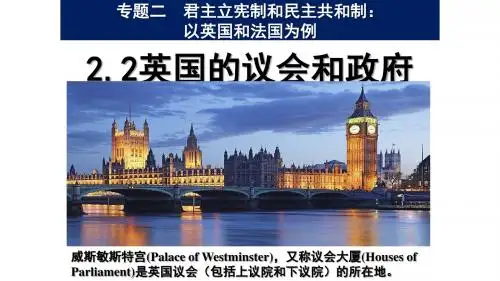
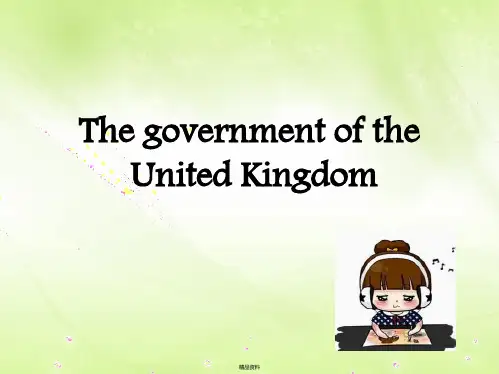
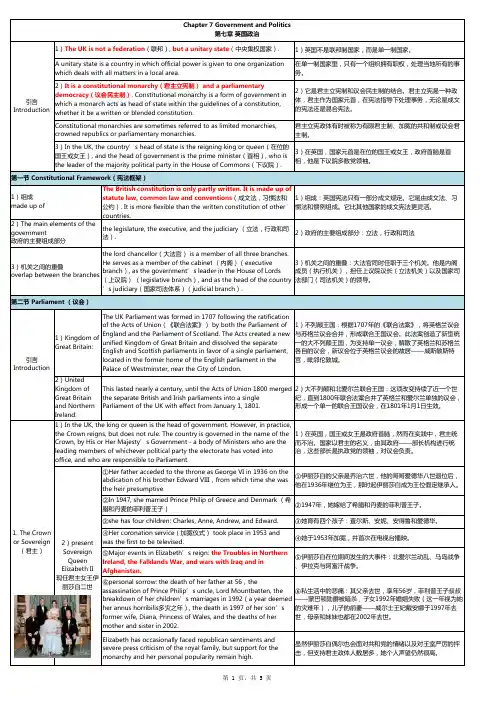
1)英国不是联邦制国家,而是单一制国家。
在单一制国家里,只有一个组织拥有职权,处理当地所有的事务。
2)它是君主立宪制和议会民主制的结合。
君主立宪是一种政体,君主作为国家元首,在宪法指导下处理事务,无论是成文的宪法还是混合宪法。
君主立宪政体有时被称为有限君主制、加冕的共和制或议会君主制。
3)在英国,国家元首是在位的国王或女王,政府首脑是首相,他是下议院多数党领袖。
The British constitution is only partly written. It is made up ofstatute law, common law and conventions(成文法,习惯法和公约). It is more flexible than the written constitution of other countries.1)组成:英国宪法只有一部分成文规定。
它是由成文法、习惯法和惯例组成。
它比其他国家的成文宪法更灵活。
the legislature, the executive, and the judiciary (立法,行政和司法).2)政府的主要组成部分:立法,行政和司法the lord chancellor(大法官) is a member of all three branches.He serves as a member of the cabinet (内阁)(executive branch), as the government’s leader in the House of Lords (上议院) (legislative branch), and as the head of the country ’s judiciary(国家司法体系)(judicial branch).3)机关之间的重叠:大法官同时任职于三个机关。
他是内阁成员(执行机关),担任上议院议长(立法机关)以及国家司法部门(司法机关)的领导。
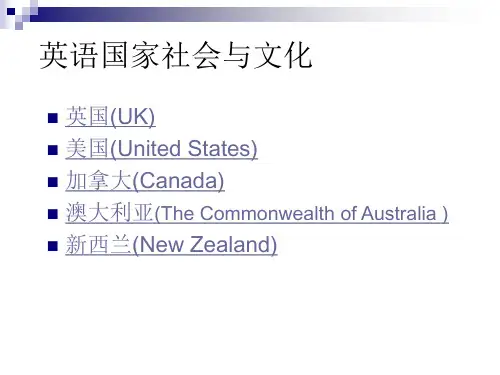
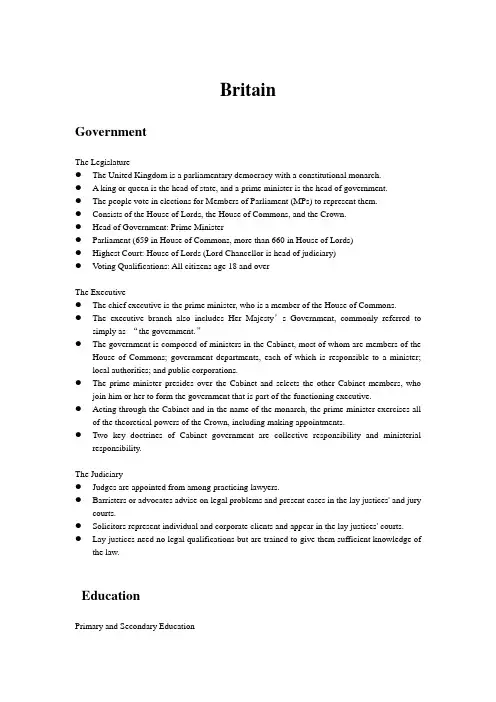
BritainGovernmentThe Legislature●The United Kingdom is a parliamentary democracy with a constitutional monarch.● A king or queen is the head of state, and a prime minister is the head of government.●The people vote in elections for Members of Parliament (MPs) to represent them.●Consists of the House of Lords, the House of Commons, and the Crown.●Head of Government: Prime Minister●Parliament (659 in House of Commons, more than 660 in House of Lords)●Highest Court: House of Lords (Lord Chancellor is head of judiciary)●V oting Qualifications: All citizens age 18 and overThe Executive●The chief executive is the prime minister, who is a member of the House of Commons.●The executive branch also includes Her Majesty’s Government, commonly referred tosimply as “the government.”●The government is composed of ministers in the Cabinet, most of whom are members of theHouse of Commons; government departments, each of which is responsible to a minister;local authorities; and public corporations.●The prime minister presides over the Cabinet and selects the other Cabinet members, whojoin him or her to form the government that is part of the functioning executive.●Acting through the Cabinet and in the name of the monarch, the prime minister exercises allof the theoretical powers of the Crown, including making appointments.●Two key doctrines of Cabinet government are collective responsibility and ministerialresponsibility.The Judiciary●Judges are appointed from among practicing lawyers.●Barristers or advocates advise on legal problems and present cases in the lay justices' and jurycourts.●Solicitors represent individual and corporate clients and appear in the lay justices' courts.●Lay justices need no legal qualifications but are trained to give them sufficient knowledge ofthe law.EducationPrimary and Secondary Education●Up to age 5, children may have some pre-primary schooling in nursery schools, daycare orplay groups.●Between the ages of 5 to 11, pupils mainly attend state sector primary schools. Theseschools are called co-educated or mixed schools because they admit both boys and girls.●From the age of 11 up to around the age of 19, students attend secondary schools. More than80% of pupils in secondary students in England and Wales attend mixed schools ; 60% in Northern Ireland; Scotland, nearly all.Higher education●only one privately funded university: the University of Buckingham●oldest universities:1) England—Oxford (12th C.) and Cambridge (13th C.)2) Scotland: St Andrews, Glasgow, Edinburgh and Aberdeen from 14th and 15th centuriesIrelandGovernment●After independence from the Great Britain, Ireland takes a polity mixed with both the Britainand the United States●The Government is headed by President, not the Queen.●The President appoints the Prime Minister, not necessarily the head of the Party in power.●The Cabinet is organized by 16 Ministers of the Government assigned by the Prime Minister ●The legislation is interpreted by a hierarchy of courts●The executive branch of the country, checked by the legislature and the judiciary●the parliament and the legal system●Education●Irish educational system is among the cheapest and best in Europe.●In Ireland, education is compulsory for children aged 6 to 15.●Primary education 6-12●Secondary education 12-18●Higher educationAmericaGovernmentThe United States of America is a constitutional, representative democracy. Power in the US ultimately derives from the citizens of the country. The nation’s leaders are chosen by elections every few years.The Constitution of the United States is the foundational document of America which forms the basis of the laws in the US and lays out the structure of the government.The constitution divides the government into three branches:The Legislative branch: The congress of the United States is laid out in two houses, the upper house or Senate, and the lower house or the House of Representatives.The Executive Branch: The executive branch of the US government is composed of the President of the United States and the Federal Bureaucracy, or all of the people who work for the President.Judicial Branch: The United States federal court system makes up the Judicial Branch of the US government. This includes federal courts, federal appeals courts, and the US Supreme Court.Education●Primary schoolAmerican children start school at the age of five years. The first year at school is called kindergarten.●Secondary schoolSecondary school most commonly consists of a total of seven years, referred to as sixth through twelfth grades●Undergraduate schoolUndergraduate school offers either a two-year degree or a four-year degree in a specific course of major.●Graduate schoolStudents who have obtained a bachelor’s degree can continue their education by pursuing one of two types of degrees.CanadaGovernment●Canada’s system of government was based on the British system of parliamentarydemocracy,which is referred to as “west minster-style”democracy●The official head of state is the Queen,who is also the queen of other former British colonies ●The Queen is represented by an official called a Governor-general●Both the queen and the Governor general occupy roles which are largely ceremonial●MPs—generally all belong to political parties●Prime minister—the party that wins the most seats forms the government and the party leaderbecome Prime Minister, the most important person in Canadian government●The Cabinet—chosen by the prime minister,consists of senior MPs from the governingparty●The Senate—appointed by the governor general,who acts on the recommendation of theprime minister.●--not like the US Senate,but analogou to the House of Lords in UKEducation●the mandatory of school is continued to the age of 16 (some is 18).●children start to go to the kindergarten at the age of 5.●after finished the programs in kindergarten, children will go to Elementary & juniorhigh/middle school.●Before going to college, people sometimes will have a program called 'victory lap' to getready to the college studying●In college, students will get Bachelor's degree then they will decide whether they will have afarther study for a Master's or a Doctorate degree.AustraliaGovernment●Government system: reflects both the British and North American models of liberaldemocracy but with unique Australian characteristics.●Three branches: the legislature, the executive and the judiciary.●The House of Representatives (Lower House)✧150 members✧Functions: It determines the government, debates and passes laws, watches over governmentadministration and expenditure, and provides a forum for public debate on issues of national importance.✧The House's other roles: debate proposed laws, watch over government expenditure,including through its committee system, and to provide a forum for public debate on issues of national importance.●The Senate✧ A check on the government of the day. It consists of 76 senators ( 12 from each state and 2from each territory)✧An equal number of senators regardless of its population✧The Senate conducts much of its work including the budget estimates accountability process.●Parties✧Major political parties:✧The Australian Labour Party(ALP) & the Coalition (the Liberals & the Nationals)✧Governor General –representative of the QueenEducation●Australia has a well-developed educational system with a very high rate of participation andsecondary completion.●Education in Australia is primarily the responsibility of the individual states.●Each state government manages the school system within their state. This means that theyprovide funds and regulation for their schools.●The education system in Australia is divided into five areas:PreschoolPrimary schoolSecondary/high schoolCareer and vocational institutionsUniversity and other tertiary institutionsNew ZealandGovernment●Independent State●Constitutional monarchy with a parliamentary democracy●No written constitution, but the Constitution Act of 1986 defines the structure of thegovernment.●Three branches of government●Legislative (parliament)●Executive (departments and agencies)●Judicial (courts)●Head of State: Queen Elizabeth II, represented by a Governor-General●The Legislaturedeveloped from the British parliamentary system known as the Westminster system of government,and is the law-making body of the New Zealand government.Consists of Sovereign and House of Representatives●The executive-The branch of the New Zealand government is made of the Cabinet ,the Prime Minister and the public sector .-The Governor General is appointed by the Sovereign on the Prime Minister's recommendation for a term of five years.●The judiciaryThe Judiciary applies the law by hearing and deciding cases. It is made up of judges and judicial officersThe judiciary (court system) is independent of the governmentEducation●Education is freely available to everyone. Nearly all schools are run by the stae. All these public school are secular and free●New Zealand offers a wide range of early childhood agencies,namely kindergratens,playcenters,preschools,etc.●Schooling in New Zealand is compulsory for all children aged 6 to 16.Most children start atage 5.●New Zealand secondary education covers Years 9 to 13. Most secondary schools aregovernment-established.●Tertiary education institutions in New Zealand include universities of technology andpolytechnics ,colleges ,Maori tertiary educational institutions and various training establishments。

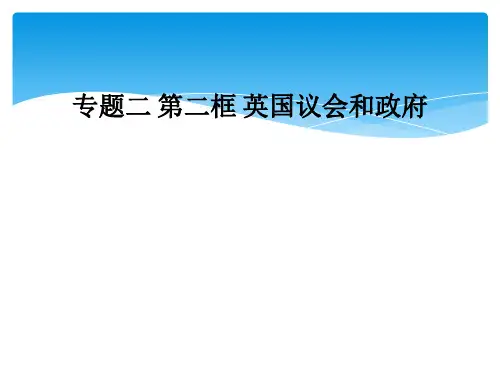
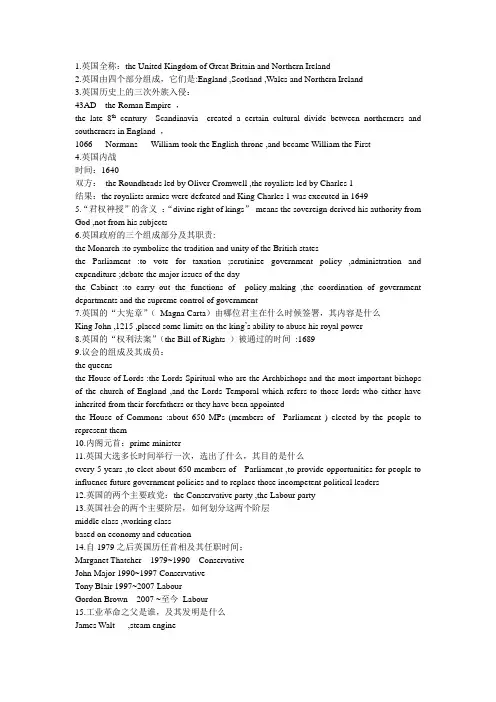
1.英国全称:the United Kingdom of Great Britain and Northern Ireland2.英国由四个部分组成,它们是:England ,Scotland ,Wales and Northern Ireland3.英国历史上的三次外族入侵:43AD the Roman Empire ,the late 8th century Scandinavia created a certain cultural divide between northerners and southerners in England ,1066 Normans William took the English throne ,and became William the First4.英国内战时间:1640双方:the Roundheads led by Oliver Cromwell ,the royalists led by Charles 1结果:the royalists armies were defeated and King Charles 1 was executed in 16495.“君权神授”的含义:“divine right of kings”means the sovereign derived his authority from God ,not from his subjects6.英国政府的三个组成部分及其职责:the Monarch :to symbolize the tradition and unity of the British statesthe Parliament :to vote for taxation ;scrutinize government policy ,administration and expenditure ;debate the major issues of the daythe Cabinet :to carry out the functions of policy-making ,the coordination of government departments and the supreme control of government7.英国的“大宪章”(Magna Carta)由哪位君主在什么时候签署,其内容是什么King John ,1215 ,placed some limits on the king’s ability to abuse his royal power8.英国的“权利法案”(the Bill of Rights )被通过的时间:16899.议会的组成及其成员:the queensthe House of Lords :the Lords Spiritual who are the Archbishops and the most important bishops of the church of England ,and the Lords Temporal which refers to those lords who either have inherited from their forefathers or they have been appointedthe House of Commons :about 650 MPs (members of Parliament ) elected by the people to represent them10.内阁元首:prime minister11.英国大选多长时间举行一次,选出了什么,其目的是什么every 5 years ,to elect about 650 members of Parliament ,to provide opportunities for people to influence future government policies and to replace those incompetent political leaders12.英国的两个主要政党:the Conservative party ,the Labour party13.英国社会的两个主要阶层,如何划分这两个阶层middle class ,working classbased on economy and education14.自1979之后英国历任首相及其任职时间:Marganet Thatcher 1979~1990 ConservativeJohn Major 1990~1997 ConservativeTony Blair 1997~2007 LabourGordon Brown 2007 ~至今Labour15.工业革命之父是谁,及其发明是什么James Walt ,steam engine16 .工业革命开始的标志:Jennifer’s hand-spinning machine17.英国教育的三个阶段及两个分枝primary education (5—11 years old ),secondary education (11-plus examination ,namely ,grammer school and comprehensive school ) ,higher educationstate school and private school18.英国最古老的报纸:the Observer (the world’s oldest national newspaper),the Times(British oldest daily newspaper)19.报纸的两大分类:the quality papers ,tabloid20.英国最大的广播公司:the British Broadcasting Corporation (BBC)21.Christmas 和Easter的意义:Christmas commemorates the birth of Jesus Christ .It is the biggest and most loved British holiday. Easter commemorates the Crucifixion and Resurrection of Jesus Christ. It is the most important Christian festival .22,英国文学:early writing :Geoffrey Chaucer ,《The Canterbury Tales》Elizabethan Drama:William Shakespeare, 《Romeo and Juliet》,《Hamlet》,《Othello》,《King Lear》,《Macbeth》the 17th century :John Milton,《Paradise Lost》,《Paradise Regained》,《Samson Agonistes》the 18th century :Jonathan Swift ,《Gulliver’s Travels》Daniel Defoe ,《Robinson Crusoe》the 19th century :Jane Austen ,《Sense and Sensibility》,《Pride and Prejudice》,《Emma》Bronte sisters,——Charlotte Bronte ,《Jane Eyre》Emily Bronte ,《Wuthering Heights》Ann BronteCharles Dickens,《Oliver Twist》,《David Copperfield》,《Great Expectation》。
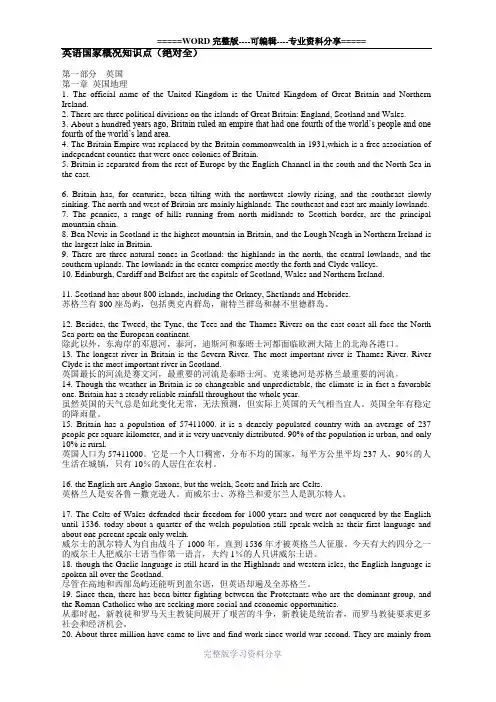
英语国家概况知识点(绝对全)第一部分英国第一章英国地理1. The official name of the United Kingdom is the United Kingdom of Great Britain and Northern Ireland.2. There are three political divisions on the islands of Great Britain: England, Scotland and Wales.3. About a hund red years ago, Britain ruled an empire that had one fourth of the world’s people and one fourth of the world’s land area.4. The Britain Empire was replaced by the Britain commonwealth in 1931,which is a free association of independent counties that were once colonies of Britain.5. Britain is separated from the rest of Europe by the English Channel in the south and the North Sea in the east.6. Britain has, for centuries, been tilting with the northwest slowly rising, and the southeast slowly sinking. The north and west of Britain are mainly highlands. The southeast and east are mainly lowlands.7. The pennies, a range of hills running from north midlands to Scottish border, are the principal mountain chain.8. Ben Nevis in Scotland is the highest mountain in Britain, and the Lough Neagh in Northern Ireland is the largest lake in Britain.9. There are three natural zones in Scotland: the highlands in the north, the central lowlands, and the southern uplands. The lowlands in the center comprise mostly the forth and Clyde valleys.10. Edinburgh, Cardiff and Belfast are the capitals of Scotland, Wales and Northern Ireland.11. Scotland has about 800 islands, including the Orkney, Shetlands and Hebrides.苏格兰有800座岛屿,包括奥克内群岛,谢特兰群岛和赫不里德群岛。


Chapt e r 1 The Land and Histo r y英国全称大不列颠及北爱尔兰联合王国,由英格兰、苏格兰、威尔士及北爱尔兰构成,位于大西洋东部的不列颠群岛,是个岛屿国家,由大不列颠岛,爱尔兰岛北部和众多小岛组成。
面积约24.40万平方公里,人口超过6400万(2013年)。
英国属于温带海洋气候,常年温和多雨,气候多变。
受高纬度因素的影响,有类似极昼极夜的现象,冬季日短夜长,夏季日长夜短。
公元前3000年左右,伊比亚人最先到达大不列颠岛。
随后,比克利人、凯尔特人相继来到不列颠。
公元前1世纪到公元5世纪,罗马入侵。
罗马人撤离后,欧洲北部的盎格鲁撒克逊人和以丹麦人为主体的斯堪的纳维亚先后入侵。
到了1066年,诺曼底公爵威廉征服了英格兰,英国的封建制度正式形成。
1215年,国王约翰被迫签订了大宪章。
不久,议会制度形成,从此英国的王权被不断削弱和限制。
1688年,―光荣革命‖爆发,确立了君主立宪制。
18世纪后期到19世纪前期,英国成为世界上第一个开始并完成工业革命的国家。
19世纪是英国发展的鼎盛时期,分别建立了第一大英帝国和第二大英帝国。
到二战前夕,英国统治了世界约1/4的土地。
第一次世界大战以及第二次世界大战的爆发,导致英国的政治、经济势力大为削弱,失去了霸权地位。
随着其殖民地的相继独立,20世纪60年代,大英帝国彻底瓦解。
I. Gener a l Intro d ucti o n1. Locat i on and the Four Natio n s The full name of the UK is the Unite d Kingd o m of Great Brita i n and North e rn Irela n d. It is made up of four natio n s: Engla n d, Scotl a nd, North e rn Irela n d, and Wales . It is locat e d to the north w est of conti n enta l Europ e , separ a ted by the Engli s h Chann e l. Geogr a phic a lly, it is an islan d count r y, cover i ng an area of about 244,019 km 2, and consi s ts of Great Brita i n and north e aste r n part of Irela n d, toget h er with many small islan d s of Briti s h Isles . Great Brita i n accou n ts for over 90% of the count r y’stotal landm a ss. It is the large s t islan d off the north w este r n coast of mainl a nd Europ e with Engla n d, Scotl a nd and Wales on it. Irela n d is the secon d large s t islan d of Briti s h Isles locat e d to the north w est of Great Brita i n. It is divid e d into two parts : North e rn Irela n d and the Repub l ic of Irela n d (an indep e nden t count r y).Engla n d is the large s t part of the UK and occup i es most of the south e rn two third s of Great Brita i n. The total area of Engla n d is 130,410 km 2 with a popul a tion of aroun d 53.9 milli o n (Mid-2013 estim a ted), which cover s morethan 84% of the total UK popul a tion . It is the most popul o us and highl y urban i zed part of the UK . Londo n , the capit a l of the UK and Engla n d, as well as the seat of gover n ment , is locat e d in its south e aste rn part.Map of Briti s h Isles Scotla nd is the second larges t and most mounta inous part of the UK in the northof GreatBritai n. Compar ed with that of Englan d, the popula tiondensit y is quitelow. Thereare only 5.3 millio n people with an area of 78,789 km2. Edinbu rgh, its larges t city, is the capita l of Scotla nd. Scotla nd is famous for its beauti ful natura l scener y, such as Scotti s h Highla nds1and Loch Ness2, as well as many histor icalplaces, like the Edinbu rgh Castle s.Walesis on the wester n side of centra l southe rn GreatBritai n. The totalarea of Walesis 20,779 km2, whichaccoun ts for 1/4 partsof the UK. It is also a mounta inous part of GreatBritai n, partic ularl y in the northand centra l region s. The southe ast region is the most builtup region of Wales, and the majori ty of its popula tionlive thereand a largepropor tionof its indust ry is basedthere. Its capita l city, Cardif f, is also in this region.Northe rn Irelan d lies in the northe ast of the island of Irelan d, coveri ng14,139 km2, whichconsti tutes 1/6 of the island. It is the smalle st part amongthe four nation s of the UK, as well as the second sparse ly popula ted part afterScotla nd. The capita l is Belfas t, the larges t city in Northe rn Irelan d both in popula tionand in area. It is the center for govern ment,econom ic, arts, higher educat ion, busine ss, law of Northe rn Irelan d. Additi onall y, it is the birthp laceof Titani c, and votedone of the world’stopdestin ation s.2. Climat eThe overal l climat e in the UK is temper ate mariti me, whichmeansthat it is mild with temper ature s neithe r much lowerthan 0℃ in winter nor much higher 32℃ in summer. Genera lly, the UK has warm summer s and cool winter s, with July and August as the warmes t month, and Januar y and Februa ry as the coldes t. Howeve r, due to the influe nce of Gulf Stream3, the summer s are cooler than thosein contin ent whilethe winter s are milder. Normal ly, the temper ature in summer is around20℃,with the high rarely goingabove30℃. The averag e temper ature in winter is around 0℃ and seldom go below-10℃ even in the most northe rn part of the countr y.Meanwh ile, sinceBritai n is an island countr y and surrou ndedby the sea, the climat e is consid erabl y change ablecompar ed with othercountr ies. Sincethe variab le climat e changi ng day to day, it is hard for people to predic t what the weathe r will be like the next day. Additi onall y, the unique geogra phica l positi on is also the reason for the dampne ss of the climat e. The rainfa ll is fairly distri buted throug houtthe year. Althou gh it does not rain everyday, it is always advisa ble for people to bringan umbrel la or waterp roofclothi ng everyday.II. Histor y1. The Foundi ng of the NationThe record ed histor y of the UK begins with the Romaninvasi on in 55BC. In 55 and 54BC, Britai n was twiceinvade d by Julius Caesar and his Romantroops. Howeve r, it was not until43AD that the Romanled by Claudi us I finall y succes sfull y invade d and Britai n became part of the RomanEmpire. The native Celtic were driven to the mounta in region s of Scotla nd and Wales, whichremain ed unconq uered by the Romans.The Romans have greatimpact on many aspect s of the Britis h cultur e. The Romancivili zatio n was introd ucedto the Britai n during this period. For exampl e, Romanstylebathsand temple s were built, cities like London and townswere constr ucted, and the system of govern mentwas also introd uced. With the declin e of the RomanEmpire, when the German ic troops attack ed Rome in 410 A.D., the Romans had to withdr aw in orderto protec t theirown nation, whichled to the end of Romanoccupa tion.Afterthe leaveof the Romans, threegroups of German ic tribes called the Jutes, the Angles and the Saxons came to Britai n from the Europe an contin ent in the mid-4th centur y. They conque red differ ent region s of Britai n:1Scotti sh Highla nds:苏格兰高地,是对苏格兰高地边界断层以西和以北的山地的称,被认为是欧洲风景最优美的地区。
英语国家概况(An Overview ofEnglishSpeaking Countries)一、英国(United Kingdom)1. 地理位置:英国位于欧洲大陆的西北边缘,由大不列颠岛、北爱尔兰和若干小岛组成。
2. 首都:伦敦(London),是英国的政治、经济、文化和交通中心。
3. 官方语言:英语4. 人口:约6600万,其中英格兰占最大比例。
5. 国旗:英国国旗被称为“米字旗”,由蓝、白、红三种颜色组成。
6. 经济:英国是世界上发达国家之一,拥有强大的金融、工业和科技实力。
7. 教育体系:英国教育体系享誉世界,牛津、剑桥等世界知名学府坐落于此。
8. 文化特色:英国有着丰富的历史文化底蕴,如莎士比亚、牛顿、披头士乐队等均诞生于此。
同时,英国也是现代足球的发源地。
二、美国(United States of America)1. 地理位置:美国位于北美洲,东临大西洋,西濒太平洋,南接墨西哥湾和加勒比海,北邻加拿大。
2. 首都:华盛顿特区(Washington, D.C.),是美国政治中心。
3. 官方语言:英语4. 人口:约3.3亿,是世界上第三人口大国。
5. 国旗:美国国旗被称为“星条旗”,由红、白、蓝三种颜色组成。
6. 经济:美国是全球最大的经济体,拥有强大的科技创新能力和金融市场。
7. 教育体系:美国教育资源丰富,世界顶尖大学如哈佛、斯坦福等均位于此。
8. 文化特色:美国文化多元化,涵盖了欧洲、亚洲、非洲等多种文化元素。
好莱坞电影、NBA篮球、美式足球等在全球具有广泛影响力。
三、加拿大(Canada)1. 地理位置:加拿大位于北美洲北部,东临大西洋,西濒太平洋,北接北冰洋,南邻美国。
2. 首都:渥太华(Ottawa),是加拿大的政治中心。
3. 官方语言:英语和法语4. 人口:约3800万,是世界上面积第二大国家。
5. 国旗:加拿大国旗被称为“枫叶旗”,由红、白两色组成。
6. 经济:加拿大经济发达,资源丰富,特别是石油、天然气和矿产资源。
英美概况知识点Part 1.英国的全称为:The United Kingdom of Great Britain and Northern Ireland,这就是英国的英文全称,有时候也可以称:The United Kingdom。
一.英国四部分是英格兰(England),首都伦敦(London),英格兰是英国面积最大、人口最多、经济最发达的一个部分。
(England is the largest, most populous and most economically developed part of Britain.)苏格兰(Scotland),首都爱丁堡(Edingburgh)威尔士(Wales),首都卡迪夫(Cadiff)北爱尔兰(Northern Ireland)、首都贝尔法斯特(Belfast)。
英国人凯尔特人(凯尔特人)作为英国本土人。
凯尔特部落从公元前750年左右从欧洲穿越而来。
C、凯尔特部落的盖尔人主要定居在北方(现代苏格兰人和爱尔兰人的祖先)。
凯尔特人的英国人。
部落(现代威尔士人的祖先),生活在原始社会。
Celts(凯尔特人)taken_as the nativeșin Britain. The Celtic tribes crossed from Europe from about 750B. C. the Gaels of the Celtic tribes mainly settled in the north (the modern Scottish and Irish's ancestors). the Britons of the Celtic . tribes(the modern Welsh's ancestors ),living in primitivesociety.盎格鲁撒克逊人英国人的祖先。
盎格鲁人、撒克逊人和朱特人属于日耳曼部落,大约在5世纪来到英国。
Unit1 A Brief Introduction to the United Kingdom 1.The flag of Britain : Union Jack(英国国旗中没有显示出Welsh旗)2. The basic information of each country:Count ry Capital AreaMemoEngland London最大1.最不会把自己的“英格兰文化区别于其他文化”2.一个高度城市化3.The time joining the British parliament: However, in 1707 by agreement of the English and Scottish parliaments, Scotland joined the Union.4.Difference between the British Isles ,UK, Great Britain , and England:British Isles:the island of Great Britainthe island of Irelandsurrounding isles●UK=Great Britain + Northern Ireland●Great Britain =England +Scotland + Wales5.The four major invasions in the history of Great Britain :At first, England was occupied by Celtic people.Then in 43AD Britain was invaded by the Roman Empire.Result: England and Wales became a part of the Roman Empire for nearly 400 years.the Angle-Saxon invaded.Result: The land they lived became" Angle-land", later changed into England, the language they spoken became English.PS:One of the best-known English legends derives from this time. In 5 century AD, King Author(亚瑟王) united the British, and with his magical sword, Excalibur(被称为“王者之剑”的圣剑),drove the Saxons back.关于亚瑟王的一些名词:Excalibur:被称为“王者之剑”的圣剑;亚瑟王之魔剑Castle at Tintagel(廷塔杰尔) in Cornwall: Tintagel传说为亚瑟王的诞生地,这是一个与亚瑟王传奇有关的地方。